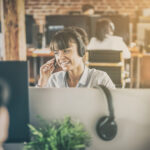
The Importance of Making ‘Back to the Office’ Worthwhile
7 February 2024
McCambridge Duffy saves almost half a million pounds per year by partnering with Apogee
12 February 2024
How businesses are meeting collaboration demands for employees, Gen X to Z
Employees have recently been voicing demand for a higher calibre of collaboration technology – something which is crucial to meeting the various priorities of workers from Gen X through to Gen Z.
A recent study has illuminated a concerning trend: out of a sample of 200 employees and 200 CIOs, a whopping 94% of employees agreed that their productivity suffers when working from home compared to when they are in the office. 98% of CIOs were quick to agree – but when it came to the root cause of this decline, opinions diverged dramatically.
When asked to identify the main obstacle to remote productivity, over a third of employees (35%) blamed insufficient, slow, and unreliable technology. However, 27% of CIOs attributed it to home distractions - effectively putting the onus squarely on employees’ home working environments.

This avoidance to address the issue of substandard tech is causing quite the disconnect between employees and employers; especially among Gen Z employees (between ages 18 – 24). 42% of Gen Z respondents say they want employers to trust them to be productive when working remotely – but 74% don’t strongly agree that this expectation is being met. This is a definite problem, considering 33% also said this trust is crucial to them feeling connected to their organisation and hybrid working colleagues.
To make matters worse, 36% of Gen Z employees say their productivity suffers due to a lack of reliable tech at home, as opposed to what they have access to in the office. And even more troubling, they aren’t the only ones - 28% of all employees in the sample agree that this is the case; and though workplace priorities vary between Gens X, Y, and Z, more reliable collaboration tech seems to be a solution that answers each of their demands.
The Generational Divide
Our sample encompassed four groups - Gen Z, Young Millennials, Older Millennials, and Gen X.
Gen Z (18-24 years)
Having entered the workplace when hybrid working was already commonplace, Gen Z are the most impacted when unreliable technology hinders communication with their colleagues - with 63% admitting it causes feelings of frustration and isolation.
Moreover, nearly 2 in 5 (39%) Gen Z employees claim work-life balance is key to their performance being optimal. However, while 24% would leave their current job if this balance was poor, a slightly higher 28% would leave if workplace tech didn’t properly support collaboration – indicating it as a surprisingly higher priority.

Young Millennials (25-34 years)
In the wake of multiple recessions, record-high inflation, and a global pandemic, Young Millennials seek stability in an unpredictable economy – and aren’t willing to tolerate substandard practices for long. 23% agreed that poor culture and management is sufficient reason to find another role; and 22% identified a lack of digital collaboration tools as an obstacle to feeling connected to their organisation and colleagues.
Another factor to consider is ‘quiet quitting’, which is a unique trend originating from Young Millennials – with 28% of our sample admitting they put less effort into their work when team collaboration is poor and not properly supported.
Older Millennials (35-44 years)
With more stability than younger Gen Ys, Older Millennials tend to have more established career paths and family commitments – with 50% saying work-life balance is a central priority, as well as being vital to them doing their best work. Yet, at 38%, they still prioritise the latest IT equipment as the most important feature to the ideal workplace, with work-life balance coming second at 33%.
Though 24% of our Older Millennial sample admitted home distractions are indeed an issue for remote productivity, 21% attributed it to lacking the right tech – with over a fifth (22%) believing that feelings of isolation and disengagement from poor hybrid communication will be the biggest hurdle for businesses to contend with for upcoming years.

Gen X (45+ years)
Though on the opposite end of our age group, Gen X employees share certain similarities with those in Gen Z – with 36% agreeing that they cannot do their job properly when poor collaboration is prevalent, and 24% agreeing that their employer doesn’t meet their workplace needs. 33% also agree that a lack of remote collaboration tech is the biggest barrier to productivity.
Yet another generation that businesses could risk alienating by not investing in collaboration tech, 50% of our Gen X employees also put work-life balance as their top priority; with a substantial 43% saying they’d leave their position if it wasn’t supported properly.
A Common Solution
As we can see, there is significant overlap between these employee priorities, all of which collaboration technology can address directly – and with demand coming from all four generations, it appears to be the easiest singular solution businesses can take to improve staff loyalty.
So what are some examples of collaboration tech, and what benefits do they bring to your business?
Make documentation easy for your remote workers to locate and access with the help of an Information Management system. Completely compatible with shared servers like Microsoft SharePoint, this kind of system makes collaboration near seamless and secure – with measures that allow files to be easily updated, backed up, shared, and most importantly, protected from threats from external and internal sources.

Minimising errors is another advantage to this kind of setup, since filing and processing tasks can be performed with Process Automation software. With this tech, your staff are enabled to be more effective – since documents such as invoices will already be filed and processed into your database correctly, meaning your remote workers should always be using the most up-to-date version of your shared server.
Clear communication between remote and office teams is made easier with a Meeting Room Equipment service. Entirely scalable to your available space, sophisticated audio-visual technology enables everybody to be heard and understood even when not in the room – preventing frustrations that would usually come from poor quality communication setups and engendering high employee satisfaction.
It’s worth noting that these examples aren’t necessarily new technology. In fact, many businesses are already experiencing improved operational efficiency, greater productivity, and higher staff satisfaction – and all as a result of enabling their hybrid teams to collaborate flexibly, and effectively.
For more information, check out our eBook, or fill out the contact form below.
Latest insights
Keep up to date with all the latest in Managed Workplace Services.
By submitting this form, you acknowledge that you have read and understand the Apogee Privacy Statement.
Data Privacy Policy | Cookies Policy













































